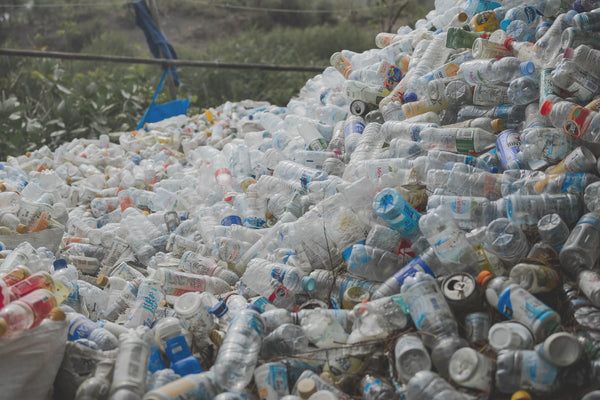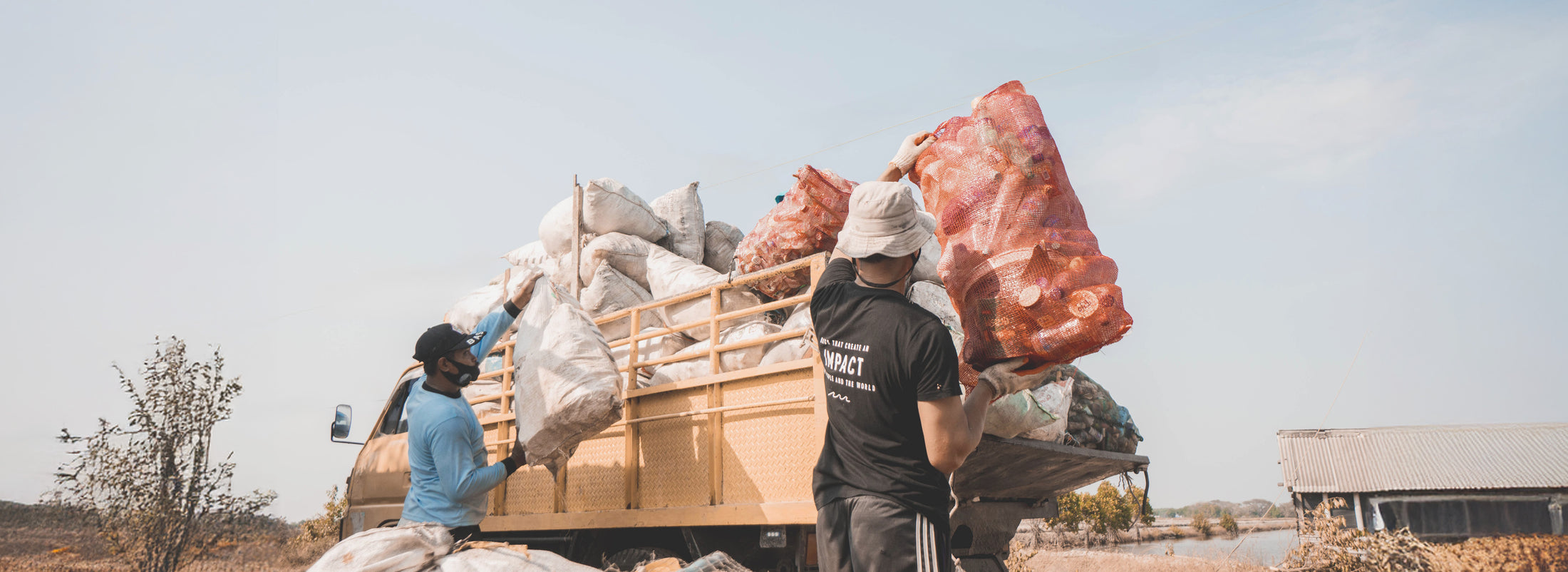PRO PACK
Nous sommes en constante évolution et travaillons à surmonter au mieux les défis et les limites de notre mission. Ici, tu découvriras les domaines dans lesquels nous rencontrons des obstacles et comment nous les abordons.
LIMIT: OCEAN PLASTIC
En 2018, nous avons lancé un projet "Fishing-for-Litter" en Indonésie, où les pêcheurs collectaient les déchets plastiques comme prises accessoires directement de la mer. Au fil du temps, le programme de nettoyage a évolué. Collecter du plastique directement de la mer devient de plus en plus coûteux et inefficace. La majorité des efforts se concentre désormais sur la collecte des déchets plastiques dans les zones côtières terrestres, y compris les plages, les rivières, les mangroves et les villages. Cette approche a un impact beaucoup plus important, car elle empêche le plastique d'atteindre l'océan en premier lieu. Le plastique déjà dans l'océan est difficile à enlever complètement, car il est dispersé par le vent et les vagues, se décompose en plus petits morceaux et coule au fond de la mer. Par conséquent, aujourd'hui, seule une petite partie des déchets plastiques collectés par notre réseau de pêcheurs est récupérée en tant que prise accessoire en mer.
En concentrant la collecte sur les zones côtières et les deltas fluviaux, le programme contribue efficacement à réduire la pollution plastique à la source, diminuant ainsi la quantité de plastique dans l'océan.
En 2023, environ 12 % des plastiques collectés par GOT BAG Indonesia provenaient directement de la mer et des voies navigables. Nous avons donné un nom spécifique à ces déchets plastiques : Ocean Impact Plastic. Cela le distingue du terme "océan plastic", qui ne fait référence qu'au plastique collecté dans les océans, tandis que "Ocean Impact Plastic" met l'accent sur l'impact positif sur les océans en empêchant le plastique d'y entrer et d'avoir des effets négatifs sur l'écosystème marin.
LIMIT : SCALABILITÉ
Nous améliorons continuellement nos opérations de nettoyage. Cependant, les quantités de plastique collectées ne répondent pas encore aux besoins de notre production de matériaux. La quantité de PET collectée dans le cadre du programme de nettoyage varie considérablement en raison de la saisonnalité et de la demande du marché. Lorsque le prix du PET est élevé, moins de bouteilles finissent dans l'environnement, car elles sont collectées plus tôt.
Pour garantir un approvisionnement constant en rPET pour le filage des fibres et la production de tissus, nous comptons à la fois sur le programme de nettoyage et sur le réseau de collecte local de notre partenaire de recyclage certifié Ocean Bound Plastic à Surabaya, Java. L'année dernière, nous avons constaté que le nombre de collecteurs de PET dans la région du nettoyage et à travers toute l'Indonésie augmentait. Nous considérons cela comme un développement positif, car certains types de plastique sont devenus précieux et offrent une opportunité économique aux personnes, avec l'avantage que moins de déchets restent dans l'environnement.
Nous prévoyons que les quantités et la part provenant d'autres réseaux de collecte continueront de croître, car le PET disponible se fait plus rare et la concurrence pour celui-ci ne correspond pas à notre mission. Cependant, nous restons engagés à développer nos opérations de nettoyage en Indonésie. Nous croyons que pour avoir un impact à long terme, il est essentiel de donner une valeur économique aux déchets plastiques, même si nous ne pouvons pas tous les utiliser dans notre production.
LIMIT : RECYCLAGE DE TOUT TYPE DE PLASTIQUE
Dans le cadre du programme de nettoyage, les communautés collectent tous les types de plastique qu'elles peuvent trouver, quelle que soit leur forme, taille ou état, car chaque déchet plastique peut nuire à la nature. Cependant, les déchets plastiques existent dans de nombreuses couleurs et structures chimiques. Pour notre tissu fabriqué à partir de Ocean Impact Plastic, nous ne pouvons actuellement utiliser que des bouteilles en PET, qui représentaient 12 % des déchets collectés en 2023. La majorité des plastiques collectés, cependant, est composée de plastiques de qualité inférieure, tels que des plastiques multilaminés ou composites, ou des déchets fortement dégradés ou non identifiables.
Actuellement, GOT BAG Indonesia envoie les plastiques non recyclables dans des usines de ciment, où ils remplacent les combustibles fossiles dans la production d'énergie. D'autres plastiques recyclables qui ne conviennent pas à la production de nos sacs sont soit envoyés à des partenaires de recyclage, soit stockés dans notre entrepôt en attendant de trouver des solutions de recyclage appropriées. En raison des technologies de recyclage limitées et des partenaires locaux, il faut du temps pour trouver la meilleure solution pour autant de types de plastiques que possible. Nous évitons strictement l'élimination en décharge, car elles sont souvent mal gérées en Indonésie et sujettes aux fuites. Par conséquent, une grande partie des plastiques collectés est utilisée pour la valorisation thermique, car actuellement peu de types peuvent être intégrés dans nos produits.
LIMIT : UTILISATION DU PLASTIQUE COLLECTÉ DANS LE CADRE DU PROGRAMME DE NETTOYAGE POUR LA FABRICATION DE PRODUITS
Les communautés du programme de nettoyage en Indonésie collectent tous types de matériaux plastiques. Cependant, tous les types de plastique ne sont pas adaptés au recyclage en fils ou en composants. De plus, seuls certains des plastiques nécessaires à nos produits peuvent être collectés dans le cadre du programme de nettoyage. Par exemple, le matériau pour les coques rigides de nos valises et pour les lunettes de soleil – le polycarbonate recyclé – provient de notre partenaire de recyclage sur l'île de Java, car les réservoirs en polycarbonate sont rarement trouvés dans les zones des activités de collecte du programme de nettoyage.
De plus, des produits comme les sacs à dos et les sacs sont composés de nombreuses pièces au-delà du matériau principal, que nous ne pouvons pas fabriquer nous-mêmes, mais que nous achetons auprès de partenaires fournisseurs. Chaque fois que cela est possible et disponible, nous choisissons des composants recyclés provenant du marché.
LIMIT : RECYCLAGE DE FILS EN PET
Tout le PET collecté par GOT BAG Indonesia n'est pas adapté à la production de fils. Pour filer un fil de haute qualité à partir de PET recyclé, il est nécessaire d'avoir un lot bien trié et homogène de PET de qualité. Les bouteilles qui ont été trop dégradées par le soleil et l'eau salée ou qui sont contaminées par de l'huile ne peuvent pas être recyclées en fil. Nous explorons des utilisations alternatives pour ce matériau, comme le recyclage en tuiles de toit.
De plus, certaines couleurs sont triées, car nous ne pouvons pas teindre le PET sombre en couleurs plus claires. Ces matériaux sont vendus à des recycleurs qui fabriquent d'autres produits.
LIMIT : POURCENTAGE DE COMPOSANTS RECYCLÉS
Depuis le début, nous nous efforçons de fabriquer nos produits à partir de plastique recyclé Ocean Impact Plastic. Jusqu'à présent, nous recyclons du PET. Cependant, de nombreux composants tels que les boucles, les sangles, les fermetures éclair, les mailles et les mousses ne peuvent pas être fabriqués à partir de PET. Par conséquent, nous utilisons pour ces articles d'autres composants recyclés provenant de fournisseurs sur le marché.
Chaque fois que cela est possible, nous nous procurons et sélectionnons des matériaux recyclés pour nos produits. Nous utilisons la plupart des composants fabriqués à partir de matériaux recyclés, la majorité étant du matériau recyclé post-consommation. Cependant, nous n'avons pas encore résolu le défi d'approvisionner en mousses (PE et PU) et en curseurs de fermetures éclair fabriqués à partir de matériaux recyclés.




















